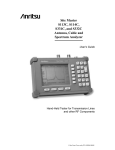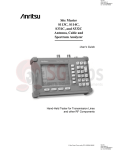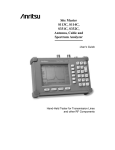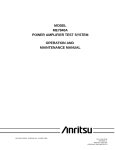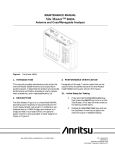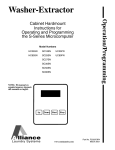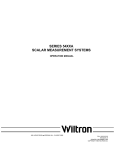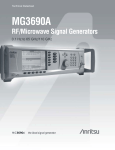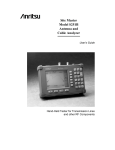Download Anritsu S332C Specifications
Transcript
Site Master™ Models S114C and S332C Antenna, Cable and Spectrum Analyzers MAINTENANCE MANUAL 490 JARVIS DRIVE · MORGAN HILL, CA 95037-2809 P/N: 10580-00068 REVISION D PRINTED: June 2009 COPYRIGHT ã 2002-2009 ANRITSU CO. Table of Contents 1. INTRODUCTION . . . . . . . . . . . . . . . . . . . . . . . . . . . . . . . . . . . . . . . . 4 2. DESCRIPTION . . . . . . . . . . . . . . . . . . . . . . . . . . . . . . . . . . . . . . . . . 4 3. SITE MASTER FREQUENCY ACCURACY . . . . . . . . . . . . . . . . . . . . . . . . . . 4 4. RETURN LOSS VERIFICATION . . . . . . . . . . . . . . . . . . . . . . . . . . . . . . . . 5 5. SPECTRUM ANALYZER FREQUENCY ACCURACY . . . . . . . . . . . . . . . . . . . . 5 6. INTERNAL REFERENCE FREQUENCY ADJUSTMENT . . . . . . . . . . . . . . . . . . 6 7. SPECTRUM ANALYZER PHASE NOISE VERIFICATION . . . . . . . . . . . . . . . . . 7 8. SPECTRUM ANALYZER SECOND HARMONIC DISTORTION TEST . . . . . . . . . . . 9 9. SPECTRUM ANALYZER RESIDUAL SPURIOUS RESPONSE TEST . . . . . . . . . . . 10 10. SPECTRUM ANALYZER RESOLUTION BANDWIDTH ACCURACY TEST . . . . . . . 12 11. SPECTRUM ANALYZER MEASUREMENT ACCURACY TEST . . . . . . . . . . . . . 13 12. DISPLAYED AVERAGE NOISE LEVEL . . . . . . . . . . . . . . . . . . . . . . . . . . 16 13. SPECTRUM ANALYZER DYNAMIC RANGE TEST . . . . . . . . . . . . . . . . . . . . 17 14. POWER MONITOR VERIFICATION . . . . . . . . . . . . . . . . . . . . . . . . . . . . 18 15. TERMINATION VERIFICATION . . . . . . . . . . . . . . . . . . . . . . . . . . . . . . 19 16. INSTACAL MODULE VERIFICATION . . . . . . . . . . . . . . . . . . . . . . . . . . . 22 17. BATTERY PACK REMOVAL AND REPLACEMENT. . . . . . . . . . . . . . . . . . . . 23 18. BATTERY INFORMATION . . . . . . . . . . . . . . . . . . . . . . . . . . . . . . . . . 24 19. FRONT PANEL ASSEMBLY REMOVAL AND REPLACEMENT . . . . . . . . . . . . . 25 20. LCD ASSEMBLY REPLACEMENT . . . . . . . . . . . . . . . . . . . . . . . . . . . . . 26 21. KEY PAD PCB REPLACEMENT . . . . . . . . . . . . . . . . . . . . . . . . . . . . . . 26 22. KEY PAD MEMBRANE REPLACEMENT . . . . . . . . . . . . . . . . . . . . . . . . . 27 23. MAIN PCB ASSEMBLY REPLACEMENT . . . . . . . . . . . . . . . . . . . . . . . . . 27 24. REPLACEABLE PARTS . . . . . . . . . . . . . . . . . . . . . . . . . . . . . . . . . . . 28 Site Master S114C/S332C MM i/ii 1. (a) Press the Preset key, then select Preset All (F1). INTRODUCTION This manual provides maintenance instructions for the Site Master Model S114C and S332C Antenna, Cable, and Spectrum Analyzers. It describes the product and provides performance verification procedures, parts replacement procedures, and a replaceable parts list. 2. (b) Press the Frequency key. (c) Press the 1 key and then the GHz key to change the Center Frequency to 1 GHz. (d) Press the Span key. (e) Press the 7, 5, 0, and kHz keys sequentially to change the Frequency Span to 750 kHz. DESCRIPTION The Site Master is a hand held SWR/RL (standing wave ratio/return loss), Distance-To-Fault and spectrum analysis measurement instrument. It combines a synthesized source, VSWR Bridge, receiver and spectrum analyzer circuitry in a compact instrument. An optional power monitor is also available. (f) Press the RBW key. (g) Press the 1, 0 and kHz keys sequentially to change the RBW to 10 kHz. (h) Press the VBW key. (i) Press the Filter Off soft key (F3) to turn the VB filter off. The following sections contain tests that can be used to verify the performance of the Site Master models S114C and S332C having any version of firmware. 3. (j) Press the Amplitude key. (k) Press the 0, and dBm keys sequentially to change the Reference Level to 0 dBm. SITE MASTER FREQUENCY ACCURACY The following test can be used to verify the CW frequency accuracy of the Site Master. Measurement calibration of the Site Master is not required for this test. a. (l) Press the Log Scale soft key (F5) (m) Select 2 dB/Div (F3) and the press the return soft key (F6). (n) Press the Marker key. Equipment Required: (o) Press the Zone Width soft key (F5). · Spectrum Analyzer Anritsu Model MS2663C or equivalent (p) Select the Spot soft key (F1). 6. b. Procedure: 1. Press and hold the ESCAPE/CLEAR key, then press the ON/OFF key to turn on the Site Master. (This sets the instrument to the factory preset state.) NOTE Before continuing, allow a five minute warm up for the internal circuitry to stabilize. 2. Press the FREQ/DIST key, then press the F1 soft key and set F1 to 1000 MHz, then press the ENTER key. 3. Press the F2 soft key, set F2 to 1000 MHz, then press the ENTER key. 4. Connect the RF cable from the Site Master Reflection Test Port to the RF Input on the MS2663C or equivalent. 5. Set up the Spectrum Analyzer as follows: Site Master S114C/S332C MM On the Site Master, press the SYS key, the OPTIONS soft key and then the FIXED CW soft key to turn Fixed CW on. NOTE If the Site Master has gone into the hold mode, press the RUN/HOLD key to return to normal mode. 7. On the Spectrum Analyzer, press A, B then the Storage soft key (F5). 8. Press the MaxHold soft key (F2). 9. When a smooth peak response appears on the Spectrum Analyzer, press the Marker Peak Search key on the Spectrum Analyzer. Verify that the marker peak readout value is 1000 MHz ±75 kHz. 10. On the Site Master, press the SYS key, the OPTIONS soft key and then the FIXED CW soft key to turn Fixed CW Off. 1 4. RETURN LOSS VERIFICATION The following test can be used to verify the accuracy of return loss measurements. Measurement calibration of the Site Master is required for this test. a. Equipment Required: · 20 dB offset, Anritsu SC5270 b. Procedure: 1. Connect the 10 MHz reference source to the Anritsu MG3692A Synthesized Signal Source. 2. Connect the output of the source to the RF Input of the Site Master. 3. Connect the external power supply (Anritsu part number 40-115) to the Site Master. 4. Press and hold the ESCAPE/CLEAR key, then press the ON/OFF key to turn on the Site Master. (This sets the instrument to the factory preset state.) 5. Turn on the 10 MHz reference source and the Anritsu MG3692A Synthesized Signal Source. 6. Set the MG3692A output to 1000 MHz CW for the S114C (2000 MHz CW for the S332C), with an RF output level of 0 dBm. · 6 dB offset, Anritsu SC5237 · Open/Short, Anritsu 22N50 · 50 Ohm Termination, Anritsu 28N50-2 or SM/PL b. Procedure: 1. Press and hold the ESCAPE/CLEAR key, then press the ON/OFF key to turn on the Site Master. (This sets the instrument to the factory preset state.) NOTE Before continuing, allow a five minute warm up for the internal circuitry to stabilize. 2. Press the MODE key. 3. Use the Up/Down arrow key to highlight RETURN LOSS, then press ENTER. 4. Press the START CAL key. 5. Follow the instructions on the screen to perform a calibration using a 22N50 Open/Short and 28N50-2 or SM/PL Termination. 6. 7. 5. Connect the 20 dB offset to the Refl Test Port and verify that the reading is 20 dB ± 1.7 dB. Connect the 6 dB offset to the Refl Test Port and verify that the reading is 6 dB ± 1.2 dB. 7. On the Site Master, press the MODE key. Use the up/down arrow key to highlight SPECTRUM ANALYZER and press ENTER to select spectrum analyzer mode. 8. Press the AMPLITUDE key and the REF LEVEL soft key. 9. Enter 20 and press the ENTER key to set the Reference Level to 20 dBm. 10. Press the FREQ/DIST key and the CENTER soft key. 11. For the S114C, enter 1000 and press the MHz soft key to set the center frequency to 1000 MHz. For the S332C, enter 2000 and press the MHz soft key to set the center frequency to 2000 MHz. 12. Press the SPAN soft key and enter 50. Press the kHz soft key to set the span to 50 kHz. 13. Press the SWEEP key. 14. Press the RBW soft key and then the MANUAL soft key. Use the Up/down arrow key to select 10 kHz. Press ENTER to set SPECTRUM ANALYZER FREQUENCY ACCURACY The following test can be used to verify the CW frequency accuracy of the Site Master Spectrum Analyzer. a. Equipment Required: · Anritsu MG3692A Synthesized Signal Source, with options 4 and 15A · 10 MHz Reference Standard 2 NOTE Before continuing, allow a 30-minute warm up for the internal circuitry to stabilize. the resolution bandwidth to 10 kHz and press the BACK soft key. Site Master S114C/S332C MM 15. Press the VBW soft key and then the MANUAL soft key. Use the Up/down arrow key to select 3 kHz. Press ENTER to set the video bandwidth to 3 kHz. 16. Press the MARKER key, then the M1 soft key. 17. Select the EDIT soft key and use the Up/down arrow key to center the marker on the waveform. Verify that the marker frequency is 1000 MHz, ± 2 kHz for the S114C, or 2000 MHz ± 4 kHz for the S332C. NOTE If the unit fails the Spectrum Analyzer Frequency Accuracy test, contact Anritsu Customer Service. 6. SPECTRUM ANALYZER PHASE NOISE VERIFICATION This test can be used to verify the phase noise of the Site Master Spectrum Analyzer. a. Press the RBW soft key and the MANUAL soft key. Use the Up/down arrow key to select 10 kHz. Press ENTER to set the resolution bandwidth to 10 kHz then press the BACK soft key. 8. Press the VBW soft key and the MANUAL soft key. Use the Up/down arrow key to select 3 kHz. Press ENTER to set the video bandwidth to 3 kHz. 9. Press the FREQ/DIST key and the CENTER soft key. 10. Enter 1000 and press the ENTER key to set the center frequency to 1000 MHz. 11. Press the SPAN soft key and enter 0.1. Press the ENTER key to set the span to 0.100 MHz. 12. Press the AMPLITUDE key. 13. Press the REF LEVEL soft key and enter –27. Press ENTER to set the reference level to –27 dBm. 14. Press the MARKER key, then the M1 soft key. 15. Press EDIT and enter 1000. Press ENTER to set the M1 marker frequency to 1000 MHz. 16. Press the BACK soft key and the M2 soft key. 17. Press EDIT and enter 1000.03. Press ENTER to set the M2 marker frequency to Equipment Required: · Anritsu MG3692A Synthesized Signal Source, with options 2A, 4 and 15A, or equivalent b. 7. Procedure: 1. 2. 3. Connect the output of the source to the Site Master RF Input. Connect the external power supply (Anritsu part number 40-115) to the Site Master. Press and hold the ESCAPE/CLEAR key, then press the ON/OFF key to turn on the Site Master. (This sets the instrument to the factory preset state.) NOTE Before continuing, allow a 30-minute warm up for the internal circuitry to stabilize. 4. Set the MG3692A output to 1000 MHz, with an RF output level of –30 dBm. 5. On the Site Master, press and hold the ESCAPE/CLEAR key, then press the ON/OFF key to turn on the Site Master. (This sets the instrument to the factory preset state.) 6. Press the SWEEP key. Site Master S114C/S332C MM 1000.03 MHz (30 kHz higher than the center frequency). 18. Press the DELTA (M2-M1) soft key. 19. Press the RUN/HOLD key and read and record the D 2 reading 20. Press the RUN/HOLD key to read and record five values, then calculate the average of the five recorded values. 21. Substract 40 dB from the average value and verify that the result is £ –75 dBc/Hz. (For example: –35 dBc measured – 40 dB = –75 dBc/Hz.) 22. (For example: –35 dBc measured + (-40 dB) = –75 dBc/Hz.) 3 NOTE The measured value is converted to dBc/Hz using the following formula: dBc / Hz = - measured dBc - 10log ( RBW 1Hz ) [ At 10 kHz RBW, 10log ( ) = 40 , so dBc / Hz = - measured dBc - 40. ] 3. Connect the external power supply (Anritsu part number 40-115) to the Site Master. 4. On the Site Master, press and hold the ESCAPE/CLEAR key, then press the ON/OFF key to turn on the Site Master. (This sets the instrument to the factory preset state.) 5. Turn on the 10 MHz reference source and the Anritsu MG3692A Synthesized Signal Source. 6. Set the MG3692A output to 40MHz CW, with an RF output level of –30 dBm. RBW 1Hz 23. Press the BACK soft key and the M3 soft key. 24. Press the EDIT key and enter 999.970. Press MHz to set the M3 marker frequency to 999.970 MHz (30 kHz lower than the center frequency). 25. Press the DELTA (M3-M1) soft key. 26. Press the RUN/HOLD key. Read and record the D 3 reading. 27. Press the RUN/HOLD key to read and record five values, then calculate the average of the five recorded values. 28. 7. Substract 40 dB from the average value and verify that the result is £ –75 dBc/Hz. (For example: –35 dBc measured – 40 dB = –75 dBc/Hz.) SPECTRUM ANALYZER SECOND HARMONIC DISTORTION TEST 7. On the Site Master, press the MODE key. Use the up/down arrow key to highlight SPECTRUM ANALZYER and press ENTER to select spectrum analyzer mode. 8. Press the AMPLITUDE key and the REF LEVEL soft key. 9. Enter –27 and press the ENTER key to set the Reference Level to –27 dBm. 10. Press the SCALE soft key and enter 7 then press ENTER. 11. Press the FREQ/DIST key and then the CENTER soft key. 12. Enter 40 and press the MHz soft key to set the center frequency to 40 MHz. 13. Press the SPAN soft key and enter 0.2. Press the MHz soft key to set the span to 0.200 MHz. · 10 MHz Reference Standard 14. Press the SWEEP key. · 50 MHz Low Pass Filter 15. Press the RBW soft key and then the MANUAL soft key. Use the Up/down arrow key to select 10 kHz. Press ENTER to set The following test can be used to verify the input related spurious response of the Site Master Spectrum Analyzer. a. NOTE Before continuing, allow a 30-minute warm up for the internal circuitry to stabilize. Equipment Required: · Anritsu MG3692A Synthesized Signal Source with options 2A, 4 and 15A, or equilvalent · RF coaxial cable, N male to N male b. 4 the resolution bandwidth to 10 kHz and select BACK. Procedure: 1. Connect the 10 MHz reference source to the Anritsu MG3692A Synthesized Signal Source. 2. Connect one end of the 50 MHz Low Pass Filter to the output of the source and the other end to the Site Master Spectrum Analyzer RF Input with the RF coaxial cable. 16. Press the VBW soft key and then the MANUAL soft key. Use the Up/down arrow key to select 3 kHz. Press ENTER to set the video bandwidth to 3 kHz. 17. Press the MARKER key, then the M1 soft key. 18. Select the EDIT soft key, then enter 40. Press the MHz soft key to set M1 to 40 MHz . Site Master S114C/S332C MM 19. On the MG3692A Synthesized Signal Source, adjust the output level so that the M1 reading of Site Master Spectrum Analyzer is –30 dBm at 40 MHz. 3. On the Site Master, press the MODE key. Use the up/down arrow key to highlight SPECTRUM ANALZYER and press ENTER to select spectrum analyzer mode. 20. On the Site Master, press the FREQ/DIST key and then the CENTER soft key. 4. Press the AMPLITUDE key and the REF LEVEL soft key. 21. Enter 80 and press the MHz soft key to set the center frequency to 80 MHz. 5. Enter –75 and press the ENTER key to set the Reference Level to –75 dBm. 22. Press the MARKER key and the M1 soft key. 6. Press the SCALE soft key and enter 5, then press ENTER. 23. Select the EDIT soft key, then enter 80. Press the MHz soft key to set M1 to 80 MHz . 7. Press the SWEEP key. 8. Press the RBW soft key and then the MANUAL soft key. Use the Up/down arrow key to select 10 kHz. Press ENTER to set 24. Record the amplitude of the signal at M1 80 MHz: the resolution bandwidth to 10 kHz and select BACK. Second Harmonic Level @ 80 MHz =____dBm 9. 25. Convert this measured value to dBc using the following formula: Press the VBW soft key and then the MANUAL soft key. Use the Up/down arrow key to select 100 Hz and press ENTER to set the video bandwidth to 100 Hz. 8. Input Related Spurious Response (dBc) = [Second Harmonic Level @ 80 MHz] + 30 dBm = ___ dBc 10. Press the FREQ/DIST key and the START soft key. 11. Enter 500 and press the kHz soft key to set the start frequency to 500 kHz. Specifications for this measurement are –45 dBc with –30 dBm into the first mixer. 12. Press the STOP soft key and enter 4, then press the MHz soft key to set the stop frequency to 4 MHz. 13. Wait till one full sweep is complete. 14. Press the MARKER key and then the M1 soft key. 15. Press the ON/OFF soft key and then the MARKER TO PEAK soft key. 16. Record the M1 amplitude reading and verify whether it is less than or equal to –90 dBm. SPECTRUM ANALYZER RESIDUAL SPURIOUS RESPONSE TEST The following test can be used to verify the residual spurious response of the Site Master Spectrum Analyzer. a. Equipment Required: · Anritsu 28N50-2 or SM/PL 50 ohm Termination or equivalent b. Procedure: 1. Connect the 50 ohm termination to the Site Master RF Input. 2. On the Site Master, press and hold the ESCAPE/CLEAR key, then press the ON/OFF key to turn on the Site Master. (This sets the instrument to the factory preset state.) NOTE Before continuing, allow a 30-minute warm up for the internal circuitry to stabilize. Site Master S114C/S332C MM NOTE If a spur with an amplitude larger than –90 dBm occurs, wait another full sweep and observe whether the spur occurs at the same point on the second sweep. If the spur does not occur at the same point on the second sweep, then the spur on the first sweep was not real. 17. Press the SWEEP key. 18. Press the VBW soft key and then the MANUAL soft key. Use the Up/down arrow key to select 3 kHz and press ENTER to set the video bandwidth to 3 kHz. 5 19. Press the FREQ/DIST key and the START soft key. 39. Press the ON/OFF soft key and then the MARKER TO PEAK soft key. 20. Enter 4 and press the MHz soft key to set the start frequency to 4 MHz. 40. Record the M1 amplitude reading and verify it is £ –90 dBm. 21. Press the STOP soft key and enter 1000, then press the MHz soft key to set the stop frequency to 1000 MHz. 22. Wait until one full sweep is complete. 23. Press the MARKER key and then the M1 soft key. 24. Press the ON/OFF soft key and then the MARKER TO PEAK soft key. 25. Record the M1 amplitude reading and verify it is £ –90 dBm. · Anritsu MG3692A Synthesized Signal Source with options 2A, 4 and 15, or equivalent 26. Press the FREQ/DIST key and the START soft key. · 10 MHz Reference Standard 27. Enter 1000 and press the MHz soft key to set the start frequency to 1000 MHz. 28. Press the STOP soft key. 29. For the S114C, enter 1600, then press the MHz soft key to set the stop frequency to 1600 MHz. 1. Connect the 10 MHz reference source to the Anritsu MG3692A Synthesized Signal Source. For the S332C, enter 2000, then press MHz soft key to set the stop frequency to 2. Connect the output of the Anritsu MG3692A Synthesized Signal Source to the Site Master Spectrum Analyzer RF Input. 3. On the Site Master, press and hold the ESCAPE/CLEAR key, then press the ON/OFF key to turn on the Site Master. (This sets the instrument to the factory preset state.) 9. SPECTRUM ANALYZER RESOLUTION BANDWIDTH ACCURACY TEST The following test can be used to verify the resolution bandwidth accuracy of the Site Master Spectrum Analyzer at four frequencies. a. Equipment Required: · 3 GHz RF cable (Nm to Nm) or equivalent b. Procedure: 2000 MHz. 30. Wait until one full sweep is complete. 31. Press the MARKER key and then the M1 soft key. 32. Press the ON/OFF soft key and then the MARKER TO PEAK soft key. 33. Record the M1 amplitude reading and verify it is £ –90 dBm. NOTE Continue on to Step 34 only if the unit being tested is a Model S332C Site Master. 6 34. Press the FREQ/DIST key and the START soft key. 35. Enter 2000 and press the MHz soft key to set the start frequency to 2000 MHz. 36. Press the STOP soft key and enter 3000, then press the MHz soft key to set the stop frequency to 3000 MHz. 37. Wait until one full sweep is complete. 38. Press the MARKER key and then the M1 soft key. NOTE Before continuing, allow a 30-minute warm up for the internal circuitry to stabilize. 4. Set the MG3692A output to 1 GHz, with an RF output level of –30 dBm. 5. On the Site Master, press the MODE key. Use the up/down arrow key to highlight SPECTRUM ANALZYER and press ENTER to select spectrum analyzer mode. 6. Press the AMPLITUDE key and the REF LEVEL soft key. 7. Enter –27 and press the ENTER key to set the Reference Level to –27 dBm. 8. Press the SCALE soft key and enter 3, then press ENTER. Site Master S114C/S332C MM 9. Press the FREQ/DIST key and the CENTER soft key. 10. Enter 1 and press the GHz soft key to set the center frequency to 1GHz. NOTE The Measured Occupied BW value for each RBW setting can be recorded in Table 1. 30 kHz RBW Test 23. Press the FREQ/DIST key. 24. Press the SPAN soft key, enter .1 and press the MHz soft key to set the span to 0.1 MHz. 25. Press the SWEEP key. 26. Press the RBW soft key and then the MANUAL soft key. Use the Up/down arrow key to select 30 kHz. Press ENTER to set 1 MHz RBW Test 11. Press the SPAN soft key, enter 5 and press the MHz soft key to set the span to 5 MHz. 12. Press the SWEEP key. 13. Press the RBW soft key and then the MANUAL soft key. Use the Up/down arrow key to select 1 MHz. Press ENTER to set the resolution bandwidth to 1 MHz and select BACK. 14. Press the VBW soft key and then the MANUAL soft key. Use the Up/down arrow key to select 3 kHz and press ENTER to set the video bandwidth to 3 kHz. 15. Press the MEASURE soft key, the OBW soft key and then the METHOD soft key to measure a 3 dB bandwidth. 16. Press the MEASURE soft key and read the displayed Meas Occ BW value. The Meas Occ BW value should be ± 20% of the RBW. the resolution bandwidth to 30 kHz and select BACK. 27. Press the MEASURE soft key, the OBW soft key and then the METHOD soft key to measure a 3 dB bandwidth. 28. Press the MEASURE soft key and read the displayed Meas Occ BW value. The Meas Occ BW value should be ± 20% of the RBW. 10 kHz RBW Test 29. Press the FREQ/DIST 30. Press the SPAN soft key, enter .04 and press the MHz soft key to set the span to 0.04 MHz. 31. Press the SWEEP key. 32. Press the RBW soft key and then the EDIT soft key. Use the Up/down arrow key to select 10 kHz. Press ENTER to set the resolution bandwidth to 10 kHz and select BACK. 33. Press the MEASURE soft key, the OBW soft key and then the METHOD soft key to measure a 3 dB bandwidth. 34. Press the MEASURE soft key and read the displayed Meas Occ BW value. The Meas Occ BW value should be ± 35% of the RBW. 100 kHz RBW Test 17. Press the FREQ/DIST key. 18. Press the SPAN soft key, enter 1 and press the MHz soft key to set the span to 1 MHz. 19. Press the SWEEP key. 20. Press the RBW soft key and then the MANUAL soft key. Use the Up/down arrow key to select 100 kHz. Press ENTER to set the resolution bandwidth to 100 kHz and select BACK. 21. 22. Table 1. RBW Setting Press the MEASURE soft key, the OBW soft key and then the METHOD soft key to measure a 3 dB bandwidth. 1 MHz Press the MEASURE soft key and read the Meas Occ BW value. The Meas Occ BW value should be ± 20% of the RBW. Site Master S114C/S332C MM RBW Check Lower Limit Measured Value Upper Limit 0.8 MHz 1.2 MHz 100 kHz 80 kHz 120 kHz 30 kHz 24 kHz 36 kHz 10 kHz 6.5 kHz 13.5 kHz 7 10. SPECTRUM ANALYZER MEASUREMENT ACCURACY TEST This test verifies the level accuracy of the Site Master Spectrum Analyzer. a. 3. Connect the external power supply (Anritsu part number 40-115) to the Site Master. 4. On the Site Master, press and hold the ESCAPE/CLEAR key, then press the ON/OFF key to turn on the Site Master. (This sets the instrument to the factory preset state.) 5. Turn on the power meter and signal source. Equipment Required: · Anritsu MG3692A Synthesized Signal Source, with options 2A, 4 and 15A · Anritsu ML2430A-Series Power Meter or equivalent NOTE Before continuing, allow a 30-minute warm up for the internal circuitry to stabilize. · Anritsu MA2442A High Accuracy Power Sensor or equivalent · Anritsu N241A50 Power Splitter or equivalent 6. On the Site Master, press the MODE key. Use the up/down arrow key to highlight SPECTRUM ANALZYER and press ENTER to select spectrum analyzer mode. 7. Press the SWEEP key. 8. Press the RBW soft key and then the MANUAL soft key. Use the Up/down arrow key to select 10 kHz. Press ENTER to set the resolution bandwidth to 10 kHz. 9. Press BACK, then the VBW soft key and then the MANUAL soft key. Use the Up/down arrow key to select 3 kHz. Press ENTER to set the video bandwidth to 3 kHz. 10. Press BACK, then MEASURE, then DETECTION, then AVERAGE. 11. Press the FREQ/DIST key. · Anritsu 34NN50A 50 ohm adapter or equivalent · Anritsu 34RSN50 50 ohm adapter or equivalent · Anritsu 15NNF50-1.5C RF Coaxial Cable or equivalent b. Procedure: 1. Connect the power sensor to the power meter and calibrate the sensor. 2. Using the power splitter, coaxial cable and adapters, connect the Site Master to the signal source and the power sensor as shown in Figure 1. ML2438A POWER METER C le a r E n try F re q u e n c y MA2442A SENSOR B a c k S p a c e L e v e l 7 8 M o d u la tio n 4 S y s te m 1 L in e 9 5 6 2 0 O u tp u t . 3 O n O ff R F O u tp u t 5 0 9 15NNF50-1.5C + /- N241A50 O p e ra te S ta n d b y MG3692A SOURCE 34NN50A ADAPTER 34RSN50 ADAPTER Site Master S332C 1 AUTO SCALE RECALL SETUP 3 5 LIMIT 7 SAVE DISPLAY 9 ON OFF MODE FREQ/DIST AMPLITUDE 2 START CAL SAVE SETUP ESCAPE CLEAR 4 6 MARKER 8 RECALL DISPLAY 0 ENTER RUN HOLD +/- PRINT . SYS SWEEP S332C Figure 1. 8 Measurement Accuracy Setup Site Master S114C/S332C MM 12. Press the SPAN soft key and enter .5, then press the MHz key to set the span to .5 MHz. 13. Press the AMPLITUDE key. 14. Press the REF LEVEL soft key, enter 20 and press the ENTER key to set the reference level to +20 dBm. 15. Press the FREQ/DIST key and the CENTER soft key. 16. Enter 50 and press the MHz soft key to set the center frequency to 50 MHz. 17. On the Anritsu ML2430A-Series Power Meter, press the Sensor key and then the CalFactor soft key. Select the FREQ soft key and enter 50 MHz for the Input Signal Frequency. This sets the power meter to the proper power sensor cal factor. 18. Set the MG3692A output to 50 MHz CW and the power level to +10 dBm as indicated on the power meter. NOTE To insure accuracy, set the output of the signal source using the power meter reading. Do not rely on the signal source display. 19. Press the MARKER key, then the M1 soft key. 20. Select the MARKER TO PEAK soft key to position the marker at the center of the response for the test frequency. NOTE Table 2 can be used to record the results of this test for future reference. 21. Verify that the M1 reading is ± 2 dB maximum from the input signal. 22. Press the AMPLITUDE key. 23. Press the REF LEVEL soft key, enter 0 and press ENTER to set the reference level to 0 dBm. 24. Set the MG3692A power level to –10 dBm as indicated on the power meter. 25. Verify that the M1 reading is ± 2 dB maximum from the input signal. 26. Press the AMPLITUDE key. 27. Press the REF LEVEL soft key, enter –20 and press ENTER to set the reference level to –20 dBm. Site Master S114C/S332C MM 28. Set the MG3692A power level to –30 dBm as indicated on the power meter. 29. Verify that the M1 reading is ± 2 dB maximum from the input signal. 30. Press the AMPLITUDE key. 31. Press the REF LEVEL soft key and enter –40. Press ENTER to set the reference level to –40 dBm. 32. Set the MG3692A power level to –50 dBm as indicated on the power meter. 33. Verify that the M1 reading is ± 2 dB maximum from the input signal. 34. Repeat steps 15 through 33 for frequencies of 500 MHz, 1000 MHz, 1500 MHz, 2000 MHz, 2500 MHz and 2950 MHz. Table 2. Measurement Accuracy Test Results Power Level (dBm) Site Master Ref Level (dBm) 50 +10 –10 –30 –50 +20 +20 –20 –40 500 +10 –10 –30 –50 +20 +20 –20 –40 1000 +10 –10 –30 –50 +20 +20 –20 –40 1500 +10 –10 –30 –50 +20 +20 –20 –40 +10 –10 –30 –50 +20 +20 –20 –40 +10 –10 –30 –50 +20 +20 –20 –40 +10 –10 –30 –50 +20 +20 –20 –40 Freq (MHz) 2000 (S332C only) 2500 (S332C only) 2950 (S332C only) M1 Reading 9 11. DISPLAYED AVERAGE NOISE LEVEL The following test can be used to verify the displayed average noise level of the Site Master Spectrum Analyzer. a. Equipment Required: · Anritsu 28N50-2 or SM/PL 50 ohm Termination or equivalent b. Enter 100 and press the kHz soft key to set the start frequency to 100 kHz. 14. Press the STOP soft key and enter 500, then press the kHz soft key to set the stop frequency to 500 kHz. 15. Wait until a full sweep is complete. 16. Press the MARKER key and then press the M1 soft key. 17. Press the MARKER TO PEAK soft key. Record the M1 amplitude reading and verify it is £ –80 dBm. 18. Press the FREQ/DIST key and the START soft key. 19. Enter 500 and press the kHz soft key to set the start frequency to 500 kHz. 20. Press the STOP soft key and enter 4, then press the MHz soft key to set the stop frequency to 4 MHz. 21. Wait until a full sweep is complete. 22. Press the MARKER key and then press the M1 soft key. 23. Press the MARKER TO PEAK soft key. Record the M1 amplitude reading and verify it is £ –95 dBm. 24. Press the SWEEP key. 25. Press the VBW soft key, and then the MANUAL soft key. Use the Up/down arrow key to select 3 kHz, and press ENTER to Procedure: 1. Connect the 50 ohm termination to the Site Master Spectrum Analyzer RF Input. 2. On the Site Master, press and hold the ESCAPE/CLEAR key, then press the ON/OFF key to turn on the Site Master. (This sets the instrument to the factory preset state.) NOTE Before continuing, allow a 30-minute warm up for the internal circuitry to stabilize. 3. On the Site Master, press the MODE key. Use the up/down arrow key to highlight SPECTRUM ANALZYER and press ENTER to select spectrum analyzer mode. 4. Press the AMPLITUDE key and the REF LEVEL soft key. 5. Enter –75 and press the ENTER key to set the Reference Level to –75 dBm. 6. Press the SCALE soft key and enter 5, then press ENTER. 7. Press the SWEEP key and then the MEASURE soft key. 8. Press the DETECTION soft key, then press AVERAGE soft key. 9. Press the SWEEP key. 10. 11. 12. 10 13. Press the RBW soft key and then the MANUAL soft key. Use the Up/down arrow key to select 10 kHz. Press ENTER to set the resolution bandwidth to 10 kHz and select BACK. Press the VBW soft key and then the MANUAL soft key. Use the Up/down arrow key to select 100 Hz and press ENTER to set the video bandwidth to 100 Hz. Press the FREQ/DIST key and the START soft key. set the video bandwidth to 3 kHz. 26. Press the FREQ/DIST key and the START soft key. 27. Enter 4 and press the MHz soft key to set the start frequency to 4 MHz. 28. Press the STOP soft key and enter 1000, then press the MHz soft key to set the stop frequency to 1000 MHz. 29. Wait until a full sweep is complete. 30. Press the MARKER key and then press the M1 soft key. 31. Press the MARKER TO PEAK soft key. Record the M1 amplitude reading and verify it is £ –95 dBm. 32. Press the FREQ/DIST key and the START soft key. 33. Enter 1000 and press the MHz soft key to set the start frequency to 1000 MHz. Site Master S114C/S332C MM 34. Press the STOP soft key. 35. For the S114C, enter 1600 then press the MHz soft key to set the stop frequency to 1600 MHz. 1. Connect the output of the Power Splitter to the RF In port of the Site Master Spectrum Analyzer. For the S332C, enter 2000 then press the MHz soft key to set the stop frequency to 2. Connect the output of the both signal sources to the input of the Power Splitter. Turn on both sources. b. Procedure: 2000 MHz. 36. Wait until a full sweep is complete. 3. 37. Press the MARKER key and then press the M1 soft key. 4. 38. Press the MARKER TO PEAK soft key. Record the M1 amplitude reading and verify it is £ –95 dBm. NOTE Continue to Step 39 only if the unit is a Site Master Model S332C. (This sets the instrument to the factory preset state.) NOTE Before continuing, allow a 30-minute warm up for the internal circuitry to stabilize. 39. Press the FREQ/DIST key and the START soft key. 5. Set the CW frequency of the first source to 1.0 GHz. 40. Enter 2000 and press the MHz soft key to set the start frequency to 2000 MHz. 6. Set the CW frequency of the second source to 1.2 GHz. 41. Press the STOP soft key and enter 3000, then press the MHz soft key to set the stop frequency to 3000 MHz. 7. On the Site Master, press the MODE key. Use the up/down arrow key to highlight SPECTRUM ANALZYER and press ENTER to select spectrum analyzer mode. 42. Wait until a full sweep is complete. 8. Press the FREQ/DIST key. 43. Press the MARKER key and then press the M1 soft key. 9. 44. Press the MARKER TO PEAK soft key. Record the M1 amplitude reading and verify it is £ –95 dBm. Press the CENTER soft key, enter 1100, then press the MHz soft key to set the center frequency to 1100 MHz. 12. SPECTRUM ANALYZER DYNAMIC RANGE TEST This test can be used to verify the dynamic range of the Site Master spectrum analyzer. a. On the Site Master, press and hold the ESCAPE/CLEAR key, then press the ON/OFF key to turn on the Site Master. Equipment required: · Two Anritsu MG3692A Synthesized Signal Sources with options 2A, 4 and 15A, or equivalent · Anritsu N241A50 Power Splitter or equivalent · Anritsu 34NN50A 50 ohm adapter or equivalent · Anritsu 34RSN50 50 ohm adapter or equivalent Site Master S114C/S332C MM 10. Press the SPAN soft key and enter 500, then press the MHz key to set the span to 500 MHz. 11. Press the AMPLITUDE key and then the REF LEVEL soft key. 12. Enter –20 and then press the ENTER key to set the reference level to –20 dBm. 13. Press the SWEEP key. 14. Press the RBW soft key and then the MANUAL soft key. Use the Up/down arrow key to select 30 kHz, the press ENTER to set the resolution bandwidth to 30 kHz. 15. Press BACK, then the VBW soft key and then the MANUAL soft key. Use the Up/down arrow key to select 30 kHz, then press ENTER to set the video bandwidth to 30 kHz. 11 16. Adjust the signal levels of both signal sources so that both signal peaks are at –20 dBm as indicated on the Site Master Spectrum Analyzer display. b. Procedure 1. Connect the DC power supply to the MA2418A Reference Source (Figure 2). 2. Connect the MA2418A Reference Source to the input of the 560-7N50B RF detector. 3. Connect the RF Detector output to the RF Detector input of the Site Master. 4. Connect the DC power supply to the appropriate line voltage to supply power to the MA2418A Reference Source. 5. Press and hold the ESCAPE/CLEAR key, then press the ON/OFF key to turn on the Site Master. (This sets the instrument to the factory preset state.) 13. POWER MONITOR VERIFICATION 6. Press the MODE soft key. If the Power Monitor (Option 5) is installed in the Site Master, the following test can be used to verify the accuracy of the power measurements. Measurement calibration of the Site Master is not required for this test. 7. Use the Up/Down arrow key to highlight POWER MONITOR, then press ENTER. 8. Press the ZERO soft key to zero the power monitor. When complete, ZERO ADJ:ON is displayed in the message area. 9. Verify that the power monitor reading is 0.0 dBm ± 1 dB. 10. Connect the output of the MA2418A Reference Source to the two attenuators so as to add 40 dB of attenuation (Figure 2). 11. Connect the MA2418A Reference Source and the attenuators to the input of the 560-7N50B RF detector. 12. Verify that the power monitor reading is now –40.0 dBm ±2 dB. 17. Referring to steps 13 through 15, set the RBW to 10 kHz and the VBW to 1 kHz. 18. Wait until the sweep is complete, then reduce the power level of the second source signal to below –85 dBm and verify that the signal is visible at below –85 dBm. NOTE Be sure to wait until the sweep is complete before changing the power level of the second source. a. Equipment Required: · RF Detector, 10 MHz to 20 GHz, Anritsu 560-7N50B · 10 dB Attenuator, Weinschel 1-10 · 30 dB Attenuator, Weinschel 1-30 · RF Reference Source, 0.050 GHz, Anritsu MA2418A · DC Power Supply, Anritsu 2000-933 Attenuators 560-7N50B RF Detector MA2418A Reference Source 50 MHz, 50 W 0dBm 15-24V DC 20 mA MA2418A Reference Source Site Master S331B 1 2 START CAL AUTO SCALE SAVE SETUP RECALL SETUP 3 5 LIMIT 7 SAVE DISPLAY 9 ON OFF MODE FREQ/DIST AMPLITUDE ESCAPE CLEAR 4 6 DC Power Supply 2000-933 MARKER 8 RECALL DISPLAY 0 ENTER RUN HOLD +/- PRINT . SYS SWEEP Site Master w/ Option 5 Installed Figure 2. 12 Power Monitor Verification Site Master S114C/S332C MM 14. TERMINATION VERIFICATION This test verifies the accuracy of the Site Master SM/PL termination using the precision return loss mode of the 541XXA Scalar Measurement System. Measurements of terminations using this mode provide results that are traceable to the NIST (National Institute of Standards and Technology) standards for the precision airline. a. 4. Using the Menu up-down keys: Highlight RESET, then press the Select key. 5. At the RESET MENU display, use the Menu up-down keys to highlight RESET TO FACTORY DEFAULTS, then press the Select key. 6. Set the signal source for the frequency range as follows: (a) Press the Frequency key. Equipment Required: (b) Using the Data Entry Keypad or Data Entry Knob, set the Start frequency to 0.01 GHz. Press the Enter key. · Scalar Measurement System, Anritsu 541XXA · Offset SWR Autotester, Anritsu 560-97A50-20 (c) Using the Data Entry Keypad or Data Entry Knob, set the Stop frequency to 4.0 GHz. Press the Enter key. · Precision Airline, Anritsu 18N50 · Open/Short, Anritsu 22N50 · 50 Ohm Termination, Anritsu 28N50-2 7. Press the Channel 2 Display On/Off key to Off. 8. Press the Channel 1 Menu key. · Source Adapter, Anritsu 34NN50A b. Procedure 1. 9. Connect the test equipment as shown in Figure 3. 2. Press the Power key on the 541XXA to On. 3. Press the System Menu key. Using the Menu up-down keys: Highlight PRECISION RL, then press the Select key. 10. At the PRECISION RETURN LOSS menu display, use the Menu up-down keys to highlight FINAL, then press the Select key. 11. Press the Calibration key. Open/Short 50 Ohm Termination Termination under Test 541XXA Scalar Measurement System Beadless End Precision Air Line Connect Dashed Line Connections When Directed By Procedure A B Source Adapter Figure 3. Offset SWR Autotester 541XXA Precision Return Loss Setup Site Master S114C/S332C MM 13 12. 13. 14. At the CALIBRATION menu display, use the Menu up-down keys to highlight START CAL, then press the Select key. Press the Select key when ready. 16. At the PRECISION RETURN LOSS CALIBRATION menu prompt, connect the Open to the beadless end of the airline. Press the Select key to start the calibration. 19. 14 + 0 .0 d B At the next menu prompt, remove the Open and connect the Short to the beadless end of the airline. Press the Select key to start the calibration process. At the next menu prompt, remove the Short and connect the 50 Ohm Termination to the beadless end of the air line. Press the Select key to start the calibration process. 20. When the calibration is complete, remove the 50 Ohm Termination. 21. Connect the SM/PL termination to the beadless end of the air line and press the Select key to begin the measurement. 22. Observe that the waveform displayed resembles that shown in Figure 5. 23. Press the Cursor On/Off key to On. 5 4 1 4 7 A C O N N E C T O P E N T O A IR L IN E P R E S S S E L E C T W H E N R E A D Y S T A R T : 0 .0 1 0 0 G H z 4 0 1 p ts Figure 4. 0 .4 G H z /D IV S T O P : 4 .0 0 0 0 G H z L E V E L + 7 .0 d B m Example of a Good Connection 24. Observe the Cursor menu readout. The minimum return loss reading for the SM/PL termination should be 42 dB. 1 : P R E C S N R L (A ) 2 : O F F 1 0 .0 d B /D IV O F F S E T + 0 .0 d B 5 4 1 4 7 A C U R S O R 1 : -4 6 .0 2 d B Verify that the display resembles that shown in Figure 4, page 14. CAUTION During both calibration and measurement, be sure to properly align the beadless connector of the airline. When the connectors are mis-aligned, a spike will usually be visible on the display. 18. O F F S E T Connect the precision air line to the Offset SWR Autotester test port. Position the air line pointing vertically upward. Downward or horizontal positions make connector pin alignment difficult. 15. 1 0 .0 d B /D IV P R E C IS IO N R E T U R N L O S S C A L IB R A T IO N At the PRECISION RETURN LOSS CALIBRATION menu display prompt, connect the Offset SWR Autotester to Input A, if you have not done so yet. NOTE Ensure that the beadless end of the precision airline is at the measurement connection point. 17. 1 : P R E C S N R L (A ) 2 : O F F 2 .4 0 5 0 G H z P R E S S S E L E C T F O R C U R S O R M E N U S T A R T : 0 .0 1 0 0 G H z 4 0 1 p ts Figure 5. 0 .4 G H z /D IV S T O P : 4 .0 0 0 0 G H z L E V E L + 7 .0 d B m Direct Readout of the Precision Return Loss 15. INSTACAL MODULE VERIFICATION This test verifies the performance of the Anritsu Site Master InstaCal Calibration Module. The InstaCal Module, part number ICN50, is an optional accessory for the S114C and S332C. NOTE Full verification of the InstaCal module over its entire frequency range (2 - 4000 MHz) requires both an S114C and S332C Site Master. However, limited verification is possible with either instrument for the frequency range of that instrument only. The frequency range of the S114C is 2 to 1600 MHz. The frequency range of the S332C is 25 to 4000 MHz. Site Master S114C/S332C MM a. Equipment Required: · InstaCal Module, part number ICN50 · 20 dB offset, Anritsu SC5270 · 6 dB offset, Anritsu SC5237 b. Selecting the NO soft key will temporarily transfer only the portion of the characterization data necessary for this particular calibration. This transfer takes aproximately 30 to 60 seconds, and will have to be repeated every time a calibration is done using this combination of Site Master and InstaCal module. Procedure NOTE If performing full verification over the entire frequency range with both an S114C and S332C Site Master, perform this procedure first on the S114C and then on the S332C. 1. Press and hold the ESCAPE/CLEAR key, then press the ON/OFF key to turn on the Site Master. (This sets the instrument to the factory preset state.) NOTE Before continuing, allow a five minute warm up for the internal circuitry to stabilize. 2. Press the MODE soft key. 3. Use the Up/Down arrow key to highlight RETURN LOSS, then press ENTER. 4. Press the START CAL key. The message “CONNECT OPEN or InstaCal TO RF Out PORT” will appear in the display. 5. Connect the InstaCal module to the RF Out port and press the ENTER key. 6. Verify that the calibration has been properly performed by checking that the CAL ON! message is displayed in the upper left corner of the display. 7. Remove the InstaCal module from the RF Out port and connect the 20 dB Offset to the RF Out port. 8. Measure the return loss of the 20 dB Offset. The level should be 20 dB, ±2 dB across the calibrated frequency range. 9. Remove the 20 dB Offset from the RF Out port and connect the 6 dB Offset to the RF Out port. 10. Measure the return loss of the 6 dB Offset. The level should be 6 dB, ±1.2 dB across the calibrated frequency range. NOTE If this particular InstaCal module has been used to calibrate this Site Master before, the Site Master senses the familiar InstaCal module and automatically calibrates the unit using the OSL procedure. If the Site Master senses that the characterization data for the InstaCal module connected to this Site Master is different than the one currently stored, it will display soft key options to keep or replace the InstaCal characterization data. Selecting the YES soft key transfers all of the characterization data from this InstaCal module to the Site Master. The transfer may take up to three minutes. This option is preferred if this InstaCal module is to stay with this particular Site Master. Once completed, the data will not need to be transfered again for this combination of Site Master and InstaCal module. Site Master S114C/S332C MM 15 16. BATTERY PACK REMOVAL AND REPLACEMENT This procedure provides instructions for removing and replacing the Site Master battery pack. NOTE Procedures in this manual may apply to many similar instruments. Photos and illustrations used are representative and may show instruments other than the S114C or S332C. 1. With the Site Master standing upright on a stable surface, locate the battery access door (Figure 9). Figure 7. Removing the Battery Access Door Figure 8. Removing the Battery BATTERY ACCESS DOOR Figure 9. 2. Battery Access Door Location Lift up the access door handle and rotate it 90 degrees counterclockwise, as illustrated in Figure 6. 5. Replacement is the opposite of removal. Note the orientation of the battery contacts, and be sure to insert the new battery with the contacts facing the rear of the unit (Figure 10). BATTERY CONTACTS Figure 6. 16 Rotate the Battery Access Door Handle 3. Lift the door and remove, as illustrated in Figure 7. 4. Grasp the battery lanyard and pull the battery straight up and out of the unit, as illustrated in Figure 8. Figure 10. Battery Orientation Site Master S114C/S332C MM 17. BATTERY INFORMATION The following information relates to the care and handling of the Site Master battery, and NiMH batteries in general. · The Nickel Metal Hydride (NiMH) battery supplied with the Site Master is shipped in a discharged state. Beore using the Site Master, the internal battery must first be charged for three hours, either in the Site Master or in the optional battery charger (Anritsu part number: 2000-1029). · Use only Anritsu approved battery packs. · Recharge the battery only in the Site Master or in an Anritsu approved charger. · With a new NiMH battery, full performance is achieved after three to five complete charge and discharge cycles. · When the Site Master or the charger is not in use, disconnect it from the power source. · Do not charge batteries for longer than 24 hours; overcharging may shorten battery life. 17.1. Battery Testing Procedure 1. NOTE If the Battery Charging LED does not light, the battery may be to low to immediately start full charging. Leaving the unit connected to AC power for several hours may bring the battery up to a level where full charging can begin. Turn the unit off and back on to see if the Battery Charging LED lights indicating a full charge cycle has begun. 2. the battery is fully charged. 3. Press and hold the ESCAPE/CLEAR key, then press the ON/OFF key to turn on the Site Master. This sets the instrument to the factory preset state. Press ENTER when prompted to continue. 4. Press the SYS key, followed by the STATUS soft key. Verify that the indicated battery charge is ³ 80%. If the value is 80% or above, press the ESCAPE/CLEAR key and continue with this procedure. · Discharge an NiMH battery from time to time to improve battery performance and battery life. If the value is lower than 80%, a discharge/charge cycle may be needed to improve the battery capacity. Completely discharge the battery, as described in Steps 5 and 6 below, and then recharge the battery as described in Steps 1 and 2. If the battery capacity does not increase after a discharge/charge cycle, replace the battery. · The battery can be charged and discharged hundreds of times, but it will eventually wear out. · The battery may need to be replaced when the operating time between charging becomes noticeably shorter than normal. · Never use a damaged or worn out charger or battery. · Storing the battery in extreme hot or cold places will reduce the capacity and lifetime of the battery. 5. Press the START CAL key (to keep the Site Master from going into HOLD mode) and make note of the test start time. 6. When the Site Master display fades and the Site Master switches itself off, make note of the test stop time. 7. The total test time (Step 5 to Step 6) should be ³ 2.5 hours. If the battery charge is near 80% and the total test time is <2.5 hours, replace the battery. · Never short-circuit the battery terminals. · Do not drop, mutilate or attempt to disassemble the battery. · Do not dispose of batteries in a fire! · Batteries must be recycled or disposed of properly. Do not place batteries in household garbage. · Always use the battery for its intended purpose only. Site Master S114C/S332C MM Disconnect the AC-DC Adapter when the Battery Charging LED turns off, indicating · If left unused a fully charged battery will discharge itself over time. · Temperature extremes will affect the ability of the battery to charge: allow the battery to cool down or warm up as necessary before use or charging. With the Site Master off and the battery installed, connect the Universal AC Adapter to the 12.5-15VDC (1100 mA) connector. The External Power LED and the Battery Charging LED will light. 17 18. FRONT PANEL ASSEMBLY REMOVAL AND REPLACEMENT 8. Remove the front panel assembly. This procedure provides instructions for removing and replacing the Site Master front panel assembly. With the front panel assembly removed, the LCD display, keypad PCB, keypad membrane, and main PCB assemblies can be removed and replaced. J15 J4 1. Place the Site Master face up on a work surface. 2. Remove the four rubber corner bumpers by carefully sliding the bumpers off of the case corners (Figure 11). J12 Figure 12. 9. Site Master Front Panel Cable Connections Reverse the above steps to replace the front panel assembly. NOTE The corner bumpers only mount one way. That is, the raised area inside one end of the bumper (Figure 12) is made to conform to the contour of the front cover only. Figure 11. 3. 4. Removing the Corner Bumpers With the bumpers removed, the access holes for the case screws are revealed. Use a Phillips screwdriver to remove the four screws securing the two halves of the Site Master case together. Carefully lift up on the right side (as viewed from the front) of the front half of the case and begin to separate the two halves. CAUTION Do not force or pull the two halves of the case apart as there are delicate cables attached between the two halves that must be disconnected first. 18 RAISED AREA 5. Carefully depress the latch tab and disconnect the LCD display cable from J12 on the main PCB. 6. Carefully disconnect the keypad interface cable from J4 on the main PCB. 7. Carefully disconnect the LCD display backlight cable from J15 on the main PCB. Figure 13. Corner Bumper Detail Site Master S114C/S332C MM 19. LCD ASSEMBLY REPLACEMENT 20. KEY PAD PCB REPLACEMENT This procedure provides instructions for removing and replacing the Liquid Crystal Display (LCD) once the front panel assembly has been separated from the Site Master. This procedure provides instructions for removing and replacing the key pad PCB. 1. 2. 3. 4. 1. Remove the front panel assembly as directed in section 18. Remove the front panel assembly as directed in section 18. 2. Place the front panel assembly face down on a protected work surface. Place the front panel assembly face down on a protected work surface. 3. Remove the 14 Phillips screws that attach the backing plate to the front panel assembly. Remove the 14 Phillips screws that attach the backing plate to the front panel assembly. 4. Release the LCD display cable from the retaining clip on the front panel backing plate (Figure 14). 5. Remove the front panel backing plate, carefully feeding the LCD cable through the access hole to avoid damage to the cable or connector. 6. Remove the rubber cushion pad from the key pad PCB and remove the PCB. Release the LCD display cable from the retaining clip on the front panel backing plate. FRONT PANEL BACKING PLATE LCD CABLE RETAINING CLIP KEYPAD PCB Figure 14. Front Panel Backing Plate 5. Remove the front panel backing plate, carefully feeding the LCD cable through the access hole to avoid damage to the cable or connector. 6. Remove the rubber cushion pad from the LCD assembly and remove the assembly. 7. Reverse the above steps to install the replacement assembly. Site Master S114C/S332C MM Figure 15. 7. Front Panel Keypad PCB Location Reverse the above steps to install the replacement assembly. 19 21. KEY PAD MEMBRANE REPLACEMENT This procedure provides instructions for replacing the key pad membrane. 1. Remove the front panel assembly as directed in section 18. 2. Remove the key pad PCB as directed in section 20. 3. Remove the keypad membrane by gently pulling the membrane up and out of the holes in the front panel. KEYPAD MEMBRANE BATTERY CONNECTOR PCB MOUNTING SCREWS (3) Figure 16. 5. Control PCB Remove the three .25” standoffs and four Phillips screws and remove the Spectrum Analyzer PCB. PCB MOUNTING SCREWS Figure 18. 4. Front Panel Keypad Membrane Reverse the above steps to install the replacement membrane. 22. MAIN PCB ASSEMBLY REPLACEMENT This procedure provides instructions for replacing the main PCB assembly with the connector panel attached. The assembly consist of two PCBs (Control and Spectrum Analyzer) which must be replaced together. 20 1. Remove the front panel assembly as directed in section 18. 2. Disconnect the battery connector from J13 on the main PCB. 3. Disconnect the semi-rigid coaxial cable from the RF In connector on the connector panel. 4. Remove the three PCB mounting screws and remove the Control PCB assembly with the connector panel attached. STANDOFFS Figure 17. 6. Spectrum Analyzer PCB Reverse the above steps to install the new main PCB. NOTE The main PCB connector panel fits into grooves in the two halves of the case. Make sure the panel is correctly aligned with the grooves before reassembling the two halves together. Site Master S114C/S332C MM 23. REPLACEABLE PARTS Replaceable parts for the Site Master Models S114C and S332C are listed below. Table 3. Replaceable Parts List Part Number Description Qty Part Number Accessories Description Qty Hardware 10580-00060 User's Guide, Site Master S113C, S114C, S331C, S332C 1 10580-00061 Programming Manual, Site Master S113C, S114C, S331C, S332C (available on disk only) 1 2300-347 Software Tools CD, Site Master 1 40-115 Universal AC Adapter 1 2000-1029 Battery Charger 22N50 Precision Short/Open, N Male 1 SM/PL Precision RF Terminator, N Male 1 OSLN50LF Precision Open/Short/Load, N Male 1 806-62 Cable Assy, Cig Plug, Female 1 800-441 Serial Interface Cable Assy 1 48258 Soft Carrying Case 1 Replaceable Parts 900-861 Pan Head Screw, 4-20, 0.365 19 900-869 Screw, 4-40, 0.875 4 900-720 Screw, 4-40, 0.187 3 900-697 Screw, 4-40, 0.312 3 785-927 M-F Stand off, 4-40, 11/16 3 900-326 Kep Nut, 4-40, 0.187 8 761-79 Cap Vinyl, Black, round 1 Case Parts 46652-1 Top Case 1 46653-1 Bottom Case 1 48231-1 Battery Door 1 790-509 790-510 790-511 Battery Door Latch (3 pieces) 46655 Case Corner Bumpers 4 46662 LCD Retainer Plate 1 48241 Foam, LCD Corners 8 48278 Foam, LCD Window 1 1 510-87 N-Connector 2 ND57371 Option 05 Input Connector with cable 1 15-102 Liquid Crystal Display Assembly 1 46659 Foam, LCD Backing 1 633-27 Rechargeable Battery, NiMH 1 46661 Foam, Keypad Backing 1 ND57961 Control and SA PCB Assembly, S114C 1 48246 Foam, Battery Door 4 720-19 Cable Clamp 1 ND57965 Control and SA PCB Assembly, S332C 1 790-515 Spring, Battery Compartment 1 ND57962 Control and SA PCB Assembly, S114C with Option 05 1 55226 ID Label, Model S114C 1 55214 ID Label, Model S332C 1 ND57966 Control and SA PCB Assembly, S332C with Option 05 1 52737-3 Keypad PCB Assy 1 46649-1 Membrane Keypad, Main 1 633-26 Lithium Coin Clock Battery 1 Site Master S114C/S332C MM 21 23.1. Anritsu Customer Service Online support and updates to the product software or documentation, if any, can be downloaded from the Anritsu Web site at: http://www.us.anritsu.com For the latest service and sales contact information in your area, please visit: http://www.anritsu.com/contact.asp





























